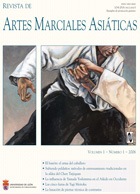El bastón: el arma del caballero
DOI:
https://doi.org/10.18002/rama.v1i1.159Resumo
Não há resumo disponívelDownloads
Métricas alternativas
Referências
ALLANSON-WINN, R. & C. PHILLIPPS-WOLLEY. (1890). Broadsword and singlestick. London: George Bell & Sons.
BALTAZZI, E. (1983). Stick fighting: A practical guide for self-protection. Rutland, VT: Charles E. Tuttle Co.
BARTON-WRIGHT, E. (1901, February). “Self-defense with a walking stick. ”Pearson’s Magazine, 11, 130-139. Reprinted at http://ejmas.com/jnc/jncart_barton-wright_0400.htm
BARTON-WRIGHT, E. (1901, January). “Self-defense with a walking stick.” Pearson’s Magazine, 11, 11-20. Reprinted at http://ejmas.com/jnc/jncart_barton-wright_0200.htm
BURTSCHER, W. (1945). The romance behind walking canes. Philadelphia: Dorrance & Co.
COLEMAN, D. (1966). Woodworking factbook. New York: Robert Speller & Sons.
DEPARTMENT OF THE ARMY (1992). Combatives: Field manual 21-150. Washington, DC.
DIKE, C. (1990). Walking sticks. Princes Risborough: Shire Publications, Ltd.
ECHANIS, M. (1978). Basic stick fighting for combat. Burbank, CA: Ohara Publications.
EVANGELISTA, N. (1998). Fighting with sticks. Port Townsend, WA: Loompanics Unlimited.
GILMAN, M. (2003). Partner cane. Port Townsend, WA: Gilman Studio. [VHS and DVD]. (Available from Gilman Studio, 913 L Street, Port Townsend, WA 98368; www.gilmanstudio.com)
GOSS, J. (2003). Hanbo: The Aiki way. Baltimore, MD: Imaginator Press.
GRANT, D. & HART, E. (1983). Shepherd’s crooks and walking sticks. Clapham: Dalesman Books.
HATSUMI, M. & CHAMBERS, Q. (1971). Stick fighting: Techniques of self defense. Tokyo: Kodansha.
HURLEY, J. (2001). Irish gangs and stick fighting in the works of William Carleton. Philadelphia: Xlibris.
HUTTON, A. (1901). The sword and the centuries or old sword days and old sword ways. London: Grant Richards.
JONES, A. & GEORGE, C. (1999). Stickmaking handbook. Lewes, UK: Guild of Master Craftsmen.
KAUFMAN, S. (2000). Zen and the art of stick fighting. Chicago: Contemporary Books.
KLEVER, U. (1996). Walking sticks. Atglen, PA: Schiffer.
LANG, H. (1923). The walking method of self-defense by “an officer of the Indian police.” London: Athletic Publications. (Boulder CO: Paladin Press, 2004 reprint).
MONEK, F. (1995). Canes through the ages. Atglen, PA: Schiffer.
MYUNG, K. (1988). The cane: Techniques. Hapkido weapons Vol. II. Los Angeles, CA: World Hapkido Federation.
NARDI, T. (1997, Sept./Oct.). “England’s stick assault.” World of Martial Arts.
PANSHIN, A., DE ZEEUW, C. & H. BROWN. (1964). Textbook of wood technology. New York: McGraw-Hill.
RECORD, S. & HESS, R. (1943). Timbers of the new world. New Haven, CT: Yale University Press.
STEIN, K. (1974). Canes & walking sticks. York, PA: Liberty Cap Books.
STYERS, J. (1952). Cold steel. Quantico, VA: Leatherneck Association. (Boulder CO: Paladin Press, 1979 reprint).
TEGNER, B. (1961). Stick-fighting for self-defense. Ventura, CA: Thor Publishing.
TEGNER, B. (1972). Stick-fighting: Self-defense. Ventura, CA: Thor Publishing.
THOMPSON, L. (2004). Stun, stagger, stop. Ventura, CA: Cold Steel, Inc. [DVD]. (Available from Cold Steel, Inc., 3036-A Seaborg Avenue, Ventura, CA 93003; www.coldsteel.com)
WAITE, J. (1880). Lessons in sabre, singlestick, sabre & bayonet, and sword feats. London: Weldon & Co.
WALLACE, G. (1972). Stick fighting for self-defense. Los Angeles: Walmac Books.
WHITMORE, T. (1973). Palms of Malaya. London: Oxford University Press. U.S. DEPARTMENT OF AGRICULTURE. (1955). Wood handbook, Handbook No. 72, 528p.
Downloads
Publicado
Como Citar
Edição
Secção
Licença
Direitos de Autor (c) 2012 Robert E. Dohrenwend

Este trabalho encontra-se publicado com a Licença Internacional Creative Commons Atribuição-NãoComercial-CompartilhaIgual 4.0.
Os autores que publicam nesta Revista estão de acordo com os seguintes termos:
- Os autores cedem, de forma exclusiva, os direitos de exploração (reprodução, distribuição, comunicação pública, transformação) à Universidade de Léon, podendo estabelecer, em separado, acordos adicionais para a distribuição não exclusiva da versão do artigo publicado na Revista (por exemplo: alojar no repertório institucional ou publicá-lo num livro), com o reconhecimento da publicação inicial nesta Revista.
- O trabalho encontra-se na Creative Commons Attribution-Non Commercial-Share Alike 4.0 International License. Pode-se consultar aqui o resumo e o texto legal da licença.
- Permite-se, e sugere-se, que os autores difundam electronicamente as versões pré-impressão (versão antes de ser avaliada) e pós-impressão (versão avaliada e aceite para publicação das suas obras antes da sua publicação), favorecendo a sua circulação e difusão, e com ela o possível aumento da sua citação e alcance pela comunidade académica.











